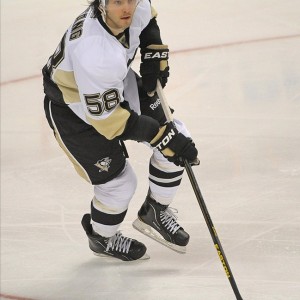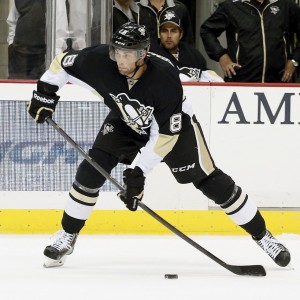When you’re as active as the Pittsburgh Penguins throughout the offseason, it comes with an abundance of predictions and expectations that the team may or may not live up to. And, when the regular season finally begins and there’s meaningful hockey being played, strengths, weaknesses, truths and myths begin to formulate. Teams begin showing their true colors.
After a number of injuries derailed the Penguins’ 2014-15 campaign, panic struck the fan base due to how much change this team would endure in the offseason and most of that change was for the worst. They were sure to lose veteran defenseman Paul Martin, as there was simply no way to afford him. With the departure of Christian Ehrhoff as well, the Penguins looked to be in trouble on the blue line.
What about on offense? Could general manager Jim Rutherford find a way to surround this core with the necessary talent in order to return to form as a Stanley Cup contender? Would the Penguins finally let go of the Craig Adams’ of the world and fulfill a roster that could contribute throughout all four lines? We all speculated. We all guessed. But, in many cases, we were all very wrong. What did we really know about this team as we approached 2015-16?
What We’ve Known About the Pittsburgh Penguins
Mike Johnston’s Hot Seat
There had been a ton of discussion about head coach Mike Johnston’s hot seat in Pittsburgh after the Penguins began the season 0-3. Since then, they’ve gone 4-1 and now sit at .500 and while there’s still a warranted call for change on the Pens’ coaching staff, it’s mainly directed at special teams. But, this exact issue, which I wrote about mid-summer, should have been expected from the moment Phil Kessel became a Penguin.
On July 1, 2015, the Penguins turned up the pressure cooker for Johnston by acquiring one of the most prolific scorers in the NHL. Somehow, Rutherford mortgaged very little in order to bring Kessel to Pittsburgh to flank arguably the two most talented centers in the game. Expectations were immediately through the roof and many weren’t prepared for a slow start. The pressure has been and will remain on Johnston to succeed with this roster.
Kris Letang Will Be Expected to Carry the Defensive Load

Is anyone surprised at how much the Penguins have relied on Letang so far? There was no question that Pittsburgh would lean heavily on the 28-year-old defenseman when they decided to stand pat on defense and deploy a very young, inexperienced group. At this point in the young season, Letang trails only Alex Pietrangelo in average ice time per game with 27 minutes. Pietrangelo averages just three seconds more per contest.
While Letang is clearly the Penguins’ best defenseman and should be considered a top-five blueliner in the league, he’s also very injury prone. That doesn’t bode well for someone logging that much ice time with no sign of relief, as Pittsburgh has no one to assume that role right now. Maybe they’ll address that need via trade at some point this season, but either way, we knew going in that Letang would be the guy. And, we knew going in that it’s very likely the Penguins will be without him at some point this season. Hopefully he can remain healthy but his history has proven otherwise.
Olli Maatta Requires Patience After Long Absence
Maatta was struck by the injury bug last season and missed all but 20 games in 2014-15. Not only did he suffer a season-ending shoulder injury, he also had a cancerous tumor removed from his neck. That’s a lot to endure for a 20-year-old kid.
When you also consider his prolonged absence from the ice, there was simply no way to expect Maatta to return to the defenseman we saw in his rookie year right away. In fact, while he’s improving each night, he still isn’t the defenseman we had all hoped for when assuming he and Letang would hold top-pairing duties together. That isn’t a knock on him, just a fact. The good news is that as long as he remains healthy, he’ll eventually get there.
What We’ve Learned About the Pittsburgh Penguins
The Penguins Can’t Score 10 Goals Every Game
Who would have thought? In all seriousness, the Penguins haven’t shown the ability to score three goals per game and that’s an issue. This team approached 2015-16 with an offense-first mentality. However, they’re the second-lowest scoring team in the NHL with only 13 goals-for through eight games.
For me, from a production standpoint, the power play is the biggest concern right now. Pittsburgh will score plenty of 5-on-5 goals once they figure out where all of these new pieces fit. But, there’s no reason for a team with this much talent to fail so often with the man advantage. They’re currently 2-for-28, which is a 7.1 percent success rate. The word horrid might be an understatement.
The Blue Line Isn’t a Dumpster Fire

What if I told you that this defensive group, which everyone had been panicked about throughout the entire summer, hasn’t been that bad? According to stats.hockeyanalysis.com, the Penguins are No. 12 in the NHL for shots-against per 60 minutes. They’re also positioned in the middle of the pack for high-danger scoring chances against. To put that in simpler terms, they’re fairly average compared to the rest of the league in shot suppression and limiting prime scoring opportunities. That should be more than enough for a team that’s expected to produce like the Penguins on offense.
Of course, there are plenty of areas in which this defensive corps can use a boost. Part of the Penguins’ offensive struggles are due to the inability of players like Rob Scuderi and Ben Lovejoy to feed their transition game successfully. And, while it hasn’t been detrimental up to this point, they lack physicality around the net and below the goal line along the wall. Adding a top-four defenseman at some point should still be at the top of Rutherford’s to-do list but I can’t fault this group too much right now. With the exception of a few names, this group has held their own pretty well.
Chris Kunitz’ Second Half of 2014-15 Wasn’t a Fluke
Kunitz started last season on fire and accrued 20 points over the first two months of the season. After that, he accrued a total of 20 points from December to April. Hardly the season anyone expected from a player coming off a 68-point effort just one year prior.
The good news was that Kunitz’ underlying numbers remained strong. He was doing the right things but found himself struck by an absurdly low shooting percentage and bad puck luck. He was sure to turn it around this season if he continued to play the right way. Eventually, he’d get those bounces to go his way, right? That’s what I assumed.
Unfortunately, like many others, I was wrong. Chris Kunitz is indeed on the downslope of his career. It seems as if age caught up to him quickly and he is proving that last season wasn’t a fluke. He’s just not the hockey player that he was two years ago. Johnston made a few line adjustments and has now shuffled Kunitz to the third line. Can he be more effective in a lesser role? We’ll find out soon enough but I surely won’t get my hopes up.